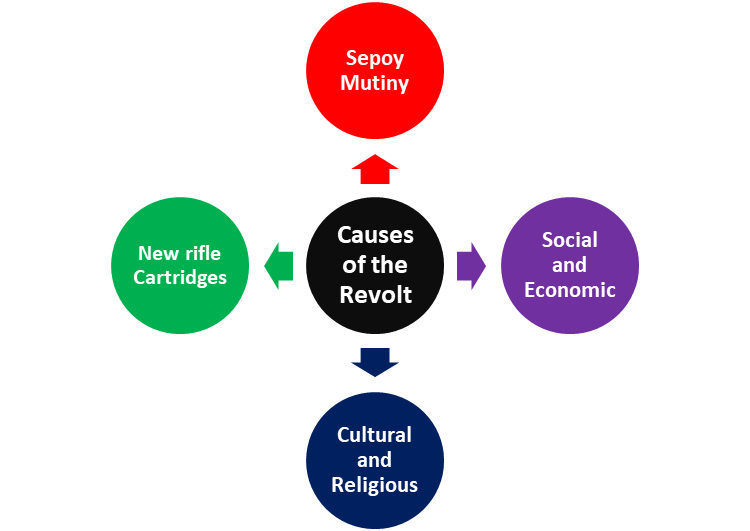The
Revolt of 1857
The Revolt of 1857, also known as the First War of Indian
Independence or the Sepoy Mutiny, was a significant uprising against
British colonial rule in India. It played a crucial role in shaping India’s
struggle for independence.
Causes
of the Revolt:
Immediate
Triggers:
Mangal Pandey Incident: In March 1857, Mangal Pandey,
a sepoy in Barrackpore, revolted against the use of the new rifle
cartridges and attacked British officers. He was subsequently hanged, becoming
a symbol of resistance.
Discontent
among Sepoys:
The sepoys (Indian soldiers in the British East India
Company’s army) were discontented due to low pay, long periods of service, and
concerns about religious practices.
Social
and Economic Factors:
The British policies led to the economic exploitation of
Indian peasants and artisans, causing widespread poverty and discontent.
Cultural
and Religious Sensitivities:
The British administration’s disregard for Indian customs and
traditions, such as the introduction of the new Enfield rifle cartridges
greased with animal fat, which offended both Hindu and Muslim soldiers.
Spread of
the Revolt:
The revolt started in Meerut on May 10, 1857, when a group
of sepoys refused to use the new cartridges and killed British officers. It
quickly spread to other parts of northern and central India, including Delhi,
Kanpur, Lucknow, Jhansi, and Awadh.
Leaders
of the Revolt:
Bahadur Shah II: The last Mughal emperor, he became a
symbol of the revolt and was proclaimed the Emperor of India by the rebels. He
was captured by the British and later exiled to Rangoon, where he died.
Rani Lakshmibai of Jhansi: She was the queen of the
princely state of Jhansi and a prominent figure in the revolt. She led her
forces against the British and became a symbol of women’s participation in the
struggle.
Kunwar Singh: He was a notable leader from Bihar and
played a crucial role in organizing resistance against the British in the
region. He is known for his guerrilla warfare tactics.
Nana Sahib: A prominent figure in Kanpur, he was the
adopted son of the former Peshwa Baji Rao II. He led the rebellion in Kanpur
and Cawnpore (now Kanpur) and is remembered for his role in the uprising.
Tantia Tope: He was a skilled military strategist who
played a key role in various battles during the revolt. He supported the
leadership of Nana Sahib and Rani Lakshmibai.
Begum Hazrat Mahal: She was the wife of Nawab Wajid
Ali Shah of Awadh and a strong leader in Lucknow. She played a significant role
in leading the resistance against the British in Awadh.
Mangal Pandey: He is often considered one of the
initial sparks of the revolt due to his rebellion against the use of the new
cartridges in Barrackpore.
Spread
and Suppression:
The revolt witnessed intense battles and sieges in various
places. The rebels briefly captured Delhi, and the British forces faced
significant resistance in cities like Lucknow and Kanpur.
The British managed to suppress the revolt through military
action and strategic alliances with local rulers who were not supportive of the
uprising.
|
Places of Revolt |
Indian Leaders |
British Officials suppressed the Revolt |
|
Delhi |
Bahadur Shah |
John |
|
Bareilly |
Khan Bahadur |
Sir Colin |
|
Lucknow |
Begum Hazrat |
Henry |
|
Kanpur |
Nana Saheb |
Sir Colin |
|
Jhansi |
Rani Lakshmi |
General Hugh |
|
Allahabad and |
Maulvi |
Colonel |
|
Bihar |
Kunwar Singh |
William |
Aftermath:
The failure of the revolt led to significant changes in
British policies and governance in India.
The British Crown took over control from the East
India Company, and India came under direct British rule (beginning the era of
the British Raj).
Indians were systematically excluded from administrative and
military positions of authority, leading to further resentment and calls for
reform.
Impact on
Indian Nationalism:
The revolt marked a turning point in India’s struggle for
independence. It demonstrated the need for a united effort against British
rule.
The brutal suppression of the revolt and the subsequent
policies of the British government fueled a growing sense of nationalism and
resistance among Indians.
The Revolt of 1857 is a complex event with various social,
economic, cultural, and political factors at play. It is considered a precursor
to the larger and more organized movements that eventually led to India’s
independence in 1947.
|
Frequently It also 1. The 2. The 3. There 4. Prominent 5. The 6. The 7. No, the 8. The 9. The 10. The 11. Religious 12. This 13. The revolt is remembered as a |
Solve: MCQ on Revolt of 1857

